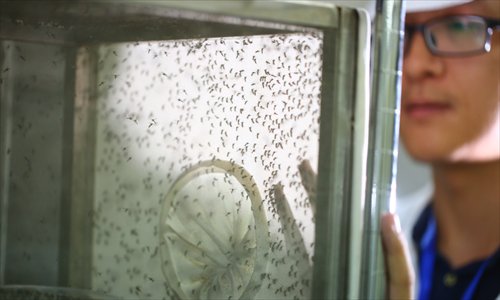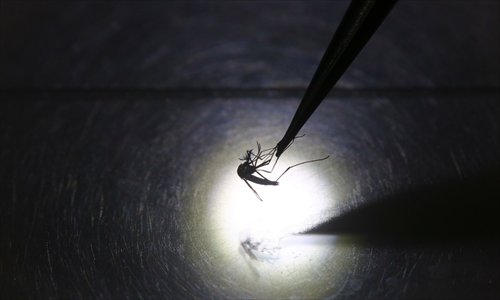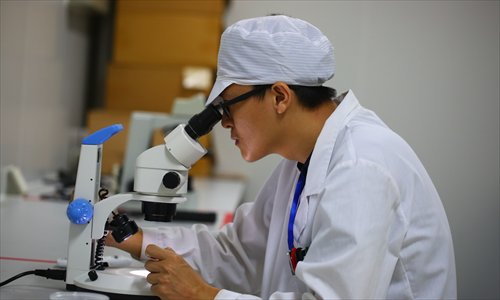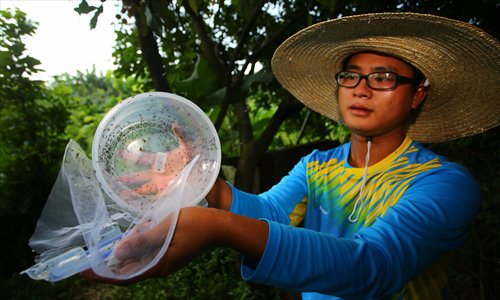HOME >> CHINA
Lab churns out infertile male mosquitoes to control insect population
Source:Global Times Published: 2016/7/25 18:58:01

A researcher observes mosquitoes breeding. Photo: IC
International Atomic Energy Agency Deputy Director Yang Dazhu visited the world's biggest "mosquito factory" in Guangzhou, South China's Guangdong Province on July 22. The factory pumps out around 3 million mosquitoes a week, all infected with a bacteria that means these pests will help fight the spread of diseases like Zika, malaria and yellow fever.
Professor Xi Zhiyong of Sun Yat-sen University developed a technique in which male mosquitoes infected with a naturally-occurring bacteria called wolbachia, which causes any eggs laid after they mate with a female to never hatch, are released into the wild to reduce the insect's population.

A male mosquito is injected with wolbachia bacteria. Photo: IC
First, mosquito eggs are injected with wolbachia around 90 days after they are laid. Researchers can inject up to 200 eggs a day.
These eggs are then placed into cages that contain three females for every male. Each cage of 4,000 mosquitoes can produce between 150,000 and 200,000 eggs.
Thirdly, the eggs are then hatched in special containers that can each hold up to 18,000 larvae each.
Fourthly, the smaller females are then separated from the larger males by filtering the insects through a glass sheet that only allows females to pass through.
Any females remaining in the swarm of males are then spotted and removed using x-ray technology, leaving a batch of exclusively sterile male mosquitoes.
Lastly, the male mosquitoes are released - about 1.5 million a month. These sterile males flood the area in which they are released, giving females in the area an 80 percent chance of breeding with a wolbachia-infected male.

A researcher monitors the incubators in which mosquitoes breed. Photo: IC
"Since female mosquitoes only mate once in their lives, we want them to mate with our (wolbachia-carrying) males so the eggs they produce will not hatch," said Xi, who leads the lab's research on the Sterile Insect Technique project.
Mosquitoes are behind the spread of many diseases. More than half a million people worldwide die from mosquito-borne diseases each year, the WHO has said, and as such research into reducing their numbers has been a key priority for many biotechnology firms.

A researcher examines mosquitoes under a microscope. Photo: IC
Xi was previous invited to Brazil to help eradicate Aedes mosquitoes, the pest that spreads the Zika virus. Zika is suspected of causing over 4,000 babies infected in the womb to be born with microcephaly - abnormally small heads - in the country.
If they win the support of the Brazilian government, Xi said his research team can build a mosquito factory in the country to stem the spread of Zika.
Last year, around 6.5 million male mosquitoes were released at experiment sites, resulting in a nearly 100-percent elimination rate of mosquito larvae in those regions.

A staff member releases wolbachia-carrying male mosquitoes into the wild to reduce the local pest population. Photo: IC
"I'm very optimistic about the application of the technology. Aedes mosquito population control is urgently needed in South America, Southeast Asia, South Asia and Africa. What we need to do now is consolidate our technology and reinforce its effectiveness and credibility and scale up production," said Xi. "The greatest merit of our technology is that we use bacteria that exists in nature. That's also why the field tests of the technology are easily approved by governments. Now many government-funded research institutes are conducting field trials of this technology, including the US, Australia, China, Singapore, Vietnam, Brazil and Columbia."
It's been two years since sterilized male mosquitoes were released on Shazai Island, Guangdong and locals said they no longer need mosquito nets at night.
Newspaper headline: Fighting pests with pests
Posted in: In-Depth